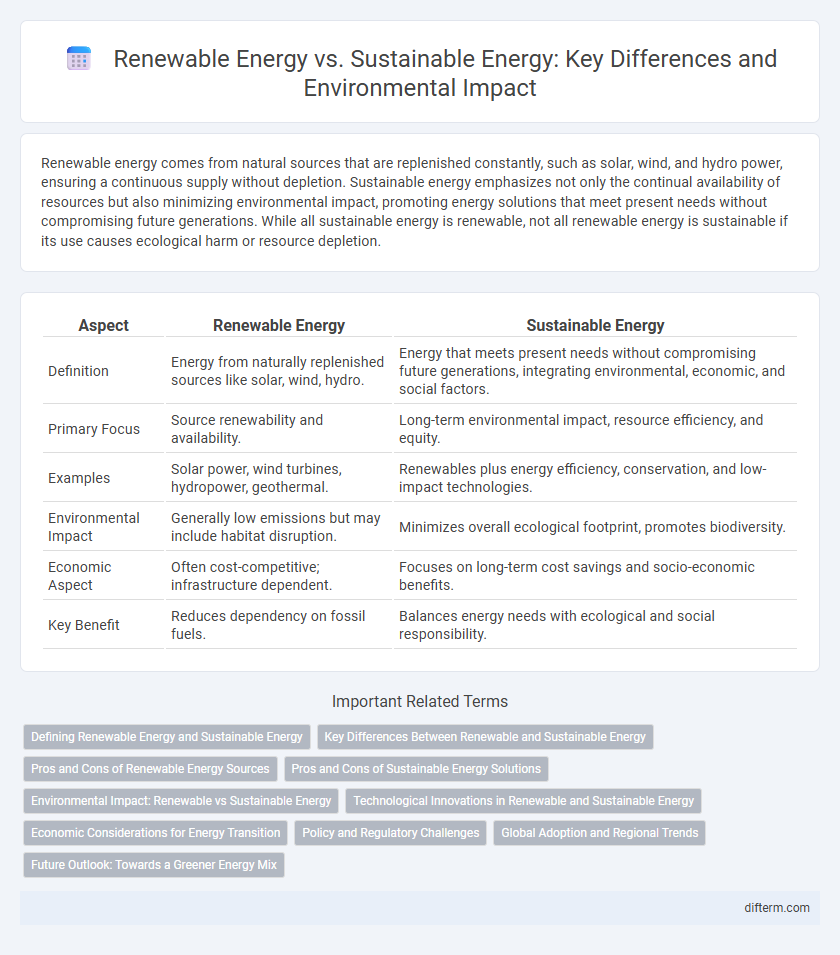Renewable energy comes from natural sources that are replenished constantly, such as solar, wind, and hydro power, ensuring a continuous supply without depletion. Sustainable energy emphasizes not only the continual availability of resources but also minimizing environmental impact, promoting energy solutions that meet present needs without compromising future generations. While all sustainable energy is renewable, not all renewable energy is sustainable if its use causes ecological harm or resource depletion.
Table of Comparison
| Aspect | Renewable Energy | Sustainable Energy |
|---|---|---|
| Definition | Energy from naturally replenished sources like solar, wind, hydro. | Energy that meets present needs without compromising future generations, integrating environmental, economic, and social factors. |
| Primary Focus | Source renewability and availability. | Long-term environmental impact, resource efficiency, and equity. |
| Examples | Solar power, wind turbines, hydropower, geothermal. | Renewables plus energy efficiency, conservation, and low-impact technologies. |
| Environmental Impact | Generally low emissions but may include habitat disruption. | Minimizes overall ecological footprint, promotes biodiversity. |
| Economic Aspect | Often cost-competitive; infrastructure dependent. | Focuses on long-term cost savings and socio-economic benefits. |
| Key Benefit | Reduces dependency on fossil fuels. | Balances energy needs with ecological and social responsibility. |
Defining Renewable Energy and Sustainable Energy
Renewable energy refers to power generated from natural sources like sunlight, wind, rain, tides, and geothermal heat that are replenished constantly, ensuring an inexhaustible supply. Sustainable energy encompasses not only the renewable nature of the resources but also emphasizes environmental impact, social equity, and economic viability to meet present and future energy needs. While all renewable energy can be sustainable, sustainable energy requires a holistic approach that integrates resource efficiency, minimal pollution, and community well-being.
Key Differences Between Renewable and Sustainable Energy
Renewable energy comes from natural sources that are replenished constantly, such as solar, wind, and hydropower, whereas sustainable energy encompasses renewable sources but also emphasizes minimizing environmental impact and promoting long-term ecological balance. Key differences include the scope of sustainability, which integrates energy efficiency, resource conservation, and social responsibility alongside energy generation. Renewable energy forms an essential subset of sustainable energy, but sustainable energy strategies require comprehensive approaches beyond just harvesting renewables.
Pros and Cons of Renewable Energy Sources
Renewable energy sources such as solar, wind, and hydroelectric power offer significant benefits including reduced greenhouse gas emissions and decreased dependency on fossil fuels, contributing to climate change mitigation. However, challenges include intermittency issues, high initial infrastructure costs, and the ecological impact of resource extraction and installation. Despite these drawbacks, renewable energy remains a crucial component of sustainable energy strategies aimed at long-term environmental preservation.
Pros and Cons of Sustainable Energy Solutions
Sustainable energy solutions offer significant environmental benefits, including reduced greenhouse gas emissions and conservation of natural resources, supporting long-term ecological balance. However, challenges such as high initial costs, technological limitations, and intermittency issues can hinder widespread adoption and efficiency of sustainable energy systems. Despite these drawbacks, advancements in energy storage and smart grid technologies are progressively enhancing the viability and reliability of sustainable energy.
Environmental Impact: Renewable vs Sustainable Energy
Renewable energy sources such as solar, wind, and hydro generate electricity with minimal greenhouse gas emissions, significantly reducing air pollution and carbon footprints compared to fossil fuels. Sustainable energy encompasses renewable sources but also emphasizes resource efficiency, ecosystem preservation, and social equity, ensuring long-term environmental health without depleting natural capital. Evaluating environmental impact involves assessing life-cycle emissions, habitat disruption, water usage, and waste generation, where sustainable energy strategies aim to minimize adverse effects while maintaining continuous energy supply.
Technological Innovations in Renewable and Sustainable Energy
Technological innovations in renewable and sustainable energy are driving advances in solar panels, wind turbines, and energy storage systems that enhance efficiency and reduce costs. Breakthroughs in battery technologies, such as solid-state batteries and grid-scale energy storage, enable better integration of intermittent renewable sources into power grids. Smart grid technology and artificial intelligence optimize energy distribution and consumption, supporting the transition toward sustainable energy systems worldwide.
Economic Considerations for Energy Transition
Renewable energy sources like solar and wind often require significant upfront investments but offer lower operational costs and long-term economic benefits through reduced fuel expenses and job creation in emerging industries. Sustainable energy emphasizes not only renewable inputs but also energy efficiency, resource conservation, and economic resilience, promoting balanced growth that supports future generations. Evaluating economic considerations for the energy transition involves analyzing initial capital, maintenance costs, market stability, and externalities such as environmental impact and social equity.
Policy and Regulatory Challenges
Policy and regulatory challenges in renewable energy focus on inconsistent subsidies, grid integration, and permit delays that hinder rapid deployment. Sustainable energy policies require comprehensive frameworks addressing lifecycle impacts, resource use, and social equity to ensure long-term viability. Regulatory reforms emphasizing adaptive standards and cross-sector collaboration are crucial for balancing renewable energy growth with sustainable development goals.
Global Adoption and Regional Trends
Global adoption of renewable energy has surged, with solar and wind power installations leading in regions such as Europe, China, and the United States due to policy incentives and technological advancements. Sustainable energy, encompassing renewable sources alongside energy efficiency and conservation measures, shows varied regional trends influenced by economic development and resource availability, notably in emerging markets in Africa and Asia. Investment flows and government mandates continue to shape the trajectory for both renewable and sustainable energy across diverse geographic and socio-economic landscapes.
Future Outlook: Towards a Greener Energy Mix
Renewable energy sources such as solar, wind, and hydroelectric power are rapidly expanding due to declining costs and technological advancements, making them central to the future energy mix. Sustainable energy emphasizes not only renewability but also environmental impact, social equity, and long-term resource management to ensure balanced ecosystem health. Integrating energy storage solutions and smart grid technologies enhances the reliability and efficiency of renewable systems, driving the transition towards a greener, low-carbon global economy.
renewable energy vs sustainable energy Infographic

 difterm.com
difterm.com